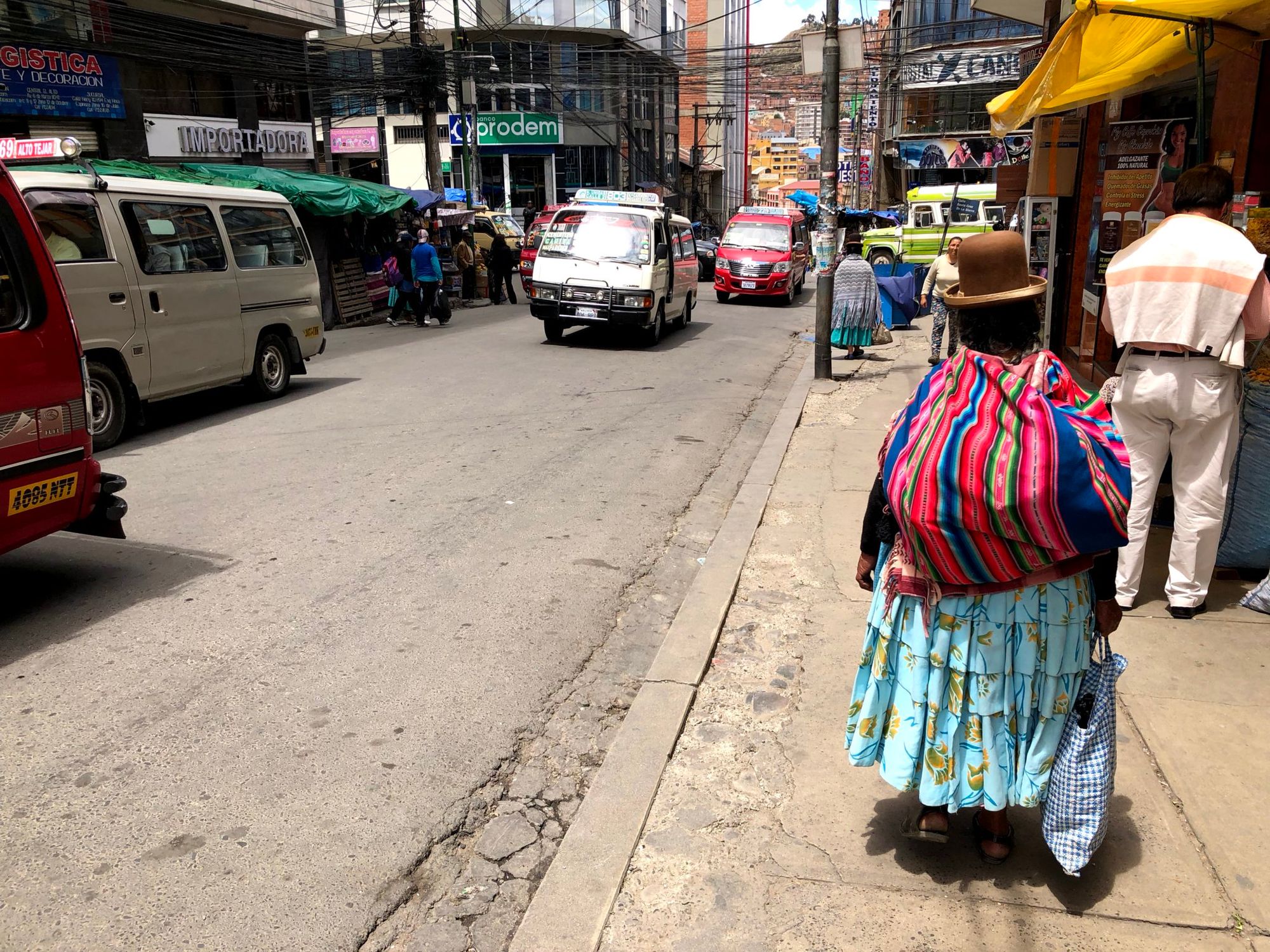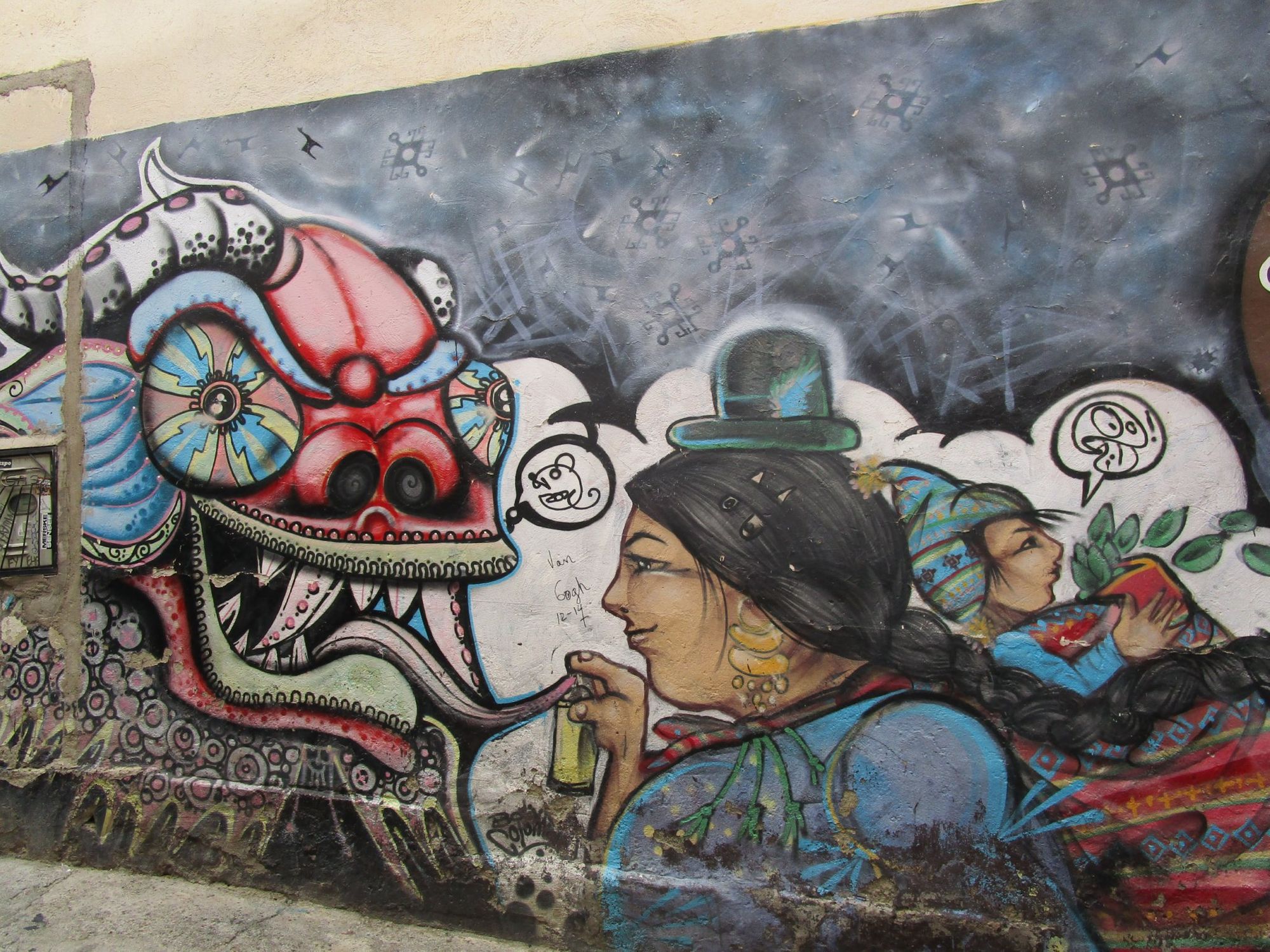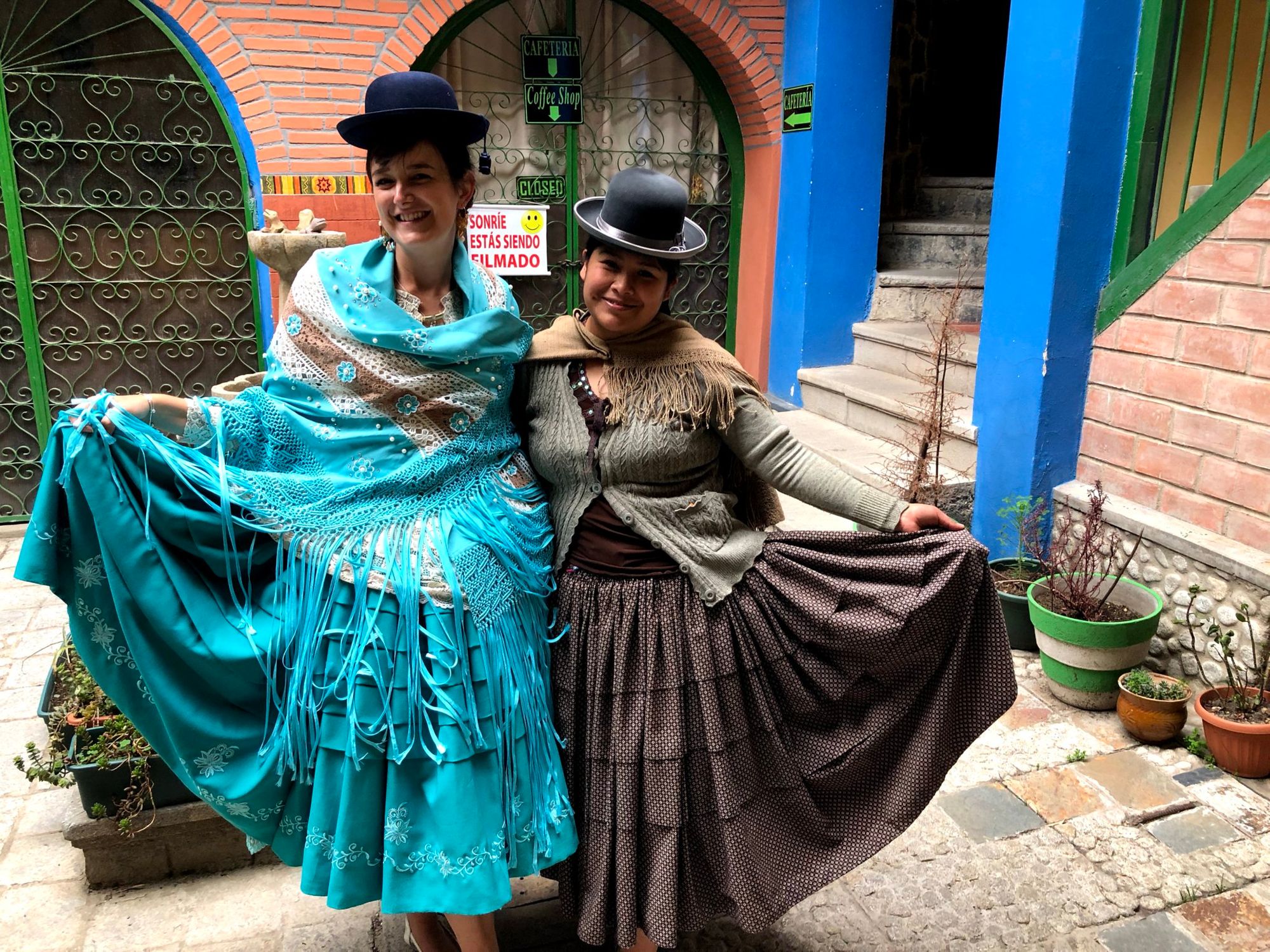La Paz: The cholita city

Our first glimpse of La Paz was breathtaking, and not just because of the altitude.
La Paz's airport is situated in the adjoining city of El Alto, perched over 4,000 metres above sea level on the flat expanse of the altiplano. When you reach the edge of El Alto the ground suddenly falls away into a vast rocky bowl covered in reddish brick buildings, surrounded by towering snow-capped volcanoes. This is La Paz: sprawling, crowded, congested, dirty, noisy, polluted and utterly compelling.

Street life in central La Paz is chaotic, a culture shock on the scale of South East Asia's most disorientating cities. We huffed and puffed up hilly streets where markets spilled across the pavement, heaped with fruit, vegetables, flowers, clothes and much more besides. The vast majority of the city's commerce takes place in these markets; everyone has their favourite place to pick up their essential daily items, their favourite seller who will reward them for their loyalty with an extra couple of potatoes or a little bit more cheese.

Central La Paz is cradled in a valley, with the main thoroughfare, the Prado, following the course of the Choqueyapu river. On the west side of the Prado is steep Sagárnaga Street, gringo central, where travel agencies and tourist-friendly cafes tumble down the hill towards San Francisco church. The surrounding streets were full of shops and stalls selling every conceivable variety of alpaca wool souvenir, the same sort of thing you see all over the Andean region.

As we wandered around looking for Christmas presents that would fit into our backpacks we came across an area with some more unusual items on offer. This was the Mercado de Hechicería, the witches' market. Here, among the familiar jumpers, fridge magnets and coca sweets, we found all manner of herbs, potions and talismans connected to traditional Aymara beliefs and shamanic medicine. Most shocking to our European eyes were the dried llama foetuses, traditionally buried in the foundations of a new house as an offering to Pachamama (mother earth), in order to ward off evil spirits and bad luck.

Other unusual items on sale included an aphrodisiac tonic called 'SEXOVIT', dead baby llamas and candles shaped like erect penises, any or all of which I thought would have made great Christmas presents for someone, but which Polly vetoed.
On the eastern side of the Prado is La Paz's cathedral, rather overshadowed by one of the city's newest and most controversial buildings, the Casa Grande del Pueblo. This 29-storey glass skyscraper is the latest manifestation of president Evo Morales's slide towards despotism, an ugly new palace he had built for himself with some $34 million of public money. Morales broke the city's own planning regulations to erect this towering vanity project, and the building is completely out of kilter with the surrounding architecture.

For many Bolivians this building is emblematic of a president who has clung onto power for too long. Morales was defeated in a referendum he held in 2016 to amend the constitution so that he could stand for a fourth consecutive term as president. Instead of honouring the result of the referendum he leaned on the constitutional court, who overruled the people's decision and declared him eligible for another term. In spite of his nosediving popularity he is expected to win the 2019 election, thanks to a lack of credible opposition candidates.
Not far from the new presidential palace is Calle Jaén, the best-preserved colonial street in the city. Most of the historic architecture in central La Paz is grubby and unloved, but the brightly coloured buildings on this street are lovingly maintained, and it's mercifully free of the traffic that plagues the rest of the city. There are several little museums along this street, including one dedicated to the 19th century War of the Pacific in which Bolivia lost its small stretch of coastline to Chile, a defeat that still rankles to this day.

Further down the street we noticed a sign outside a shop inviting tourists to dress up as a cholita, and learn more about cholita culture. Cholita (or chola) was originally a derogatory term, used to describe indigenous women in big cities who continued to wear their traditional costumes. Until recently cholitas faced shocking levels of discrimination, refused entry to certain restaurants, public squares and even buses.
These days cholitas have something of a spring in their step, symbolic of an increasingly emboldened (and increasingly wealthy) indigenous middle class. Inside the shop we met Rosario, a charming Aymara lady who told us a little about her culture while she helped Polly change into traditional dress. The classic cholita look involves several layers of big, puffy skirts and petticoats, long plaited hair, a shawl (or manta) secured with a brooch, and the distinctive bowler hat, originally brought to Bolivia for railway workers in the 1920s and known here as a borsalino.

All the skirts layered on top of each other create a body shape that doesn't seem particularly flattering, but Rosario explained that big hips and a plump backside are very desirable in Aymara culture.
"Big hips means you will have many babies!"

Clothing is not the only way in which Bolivia's newly confident indigenous population is expressing itself. Recent years have seen the emergence of a new style of architecture known as New Andean, especially in La Paz's neighbouring city of El Alto. El Alto used to be considered a district of La Paz, but has now swollen to become a city in its own right, and we decided to arrange a tour to take a closer look at some of its more unusual buildings.
We met our guide, Mariana, outside San Francisco church, where she bundled us into a minibus. We hopped out again at the old train station, where we transferred to the red line of La Paz's shiny new cable car network. Built by an Austrian-Swiss company, this unique public transport system is perfectly suited to the city's mountainous terrain. The first three lines opened in 2014 - red, yellow and green, the colours of the Bolivian flag - and there are now eight lines in operation, with three more scheduled for completion in 2019. It's one of the more impressive legacies of Evo Morales's presidency, and he has rather modestly plastered the cars with pictures of his face.

Fares are cheap at just 3 bolivianos for a single journey (about 35 pence), and were deliberately designed to undercut the city's minibuses and reduce the amount of traffic on the roads. The stations are modern, clean and efficiently run; as Polly pointed out, it seemed like the sort of thing you'd expect a city to build if it was hosting the Olympics.
As the cable car soared up to the dizzying heights of El Alto we were treated to dazzling views of the streets below, and we started to spot examples of the city's unique architecture. Eventually we disembarked and got into a taxi, which took the three of us to a run-down part of the city where the road petered out into an unsealed gravel track and packs of dogs scavenged food from huge piles of rubbish. It seemed an unlikely destination for a tourist itinerary, but this area is home to the Wiphala Project, one of El Alto's most colourful housing developments.

This collection of tower blocks was built to rehouse families made homeless by the frequent landslides that affect La Paz, and the facades are adorned with colourful murals by the famous Aymara artist Roberto Mamani Mamani. The murals are inspired by indigenous culture, with scenes depicting Pachamama, coca leaves, and wildlife such as the Andean condor. These brightly coloured towers are something of an El Alto landmark, and you can see them from the plane when you land at the airport. But Mariana explained that they are also something of a white elephant; the rent is expensive by Bolivian standards, at around $200 a month, and the families who they were intended for can't afford to live there, so most of the apartments are empty.

After a short stroll around the bleak streets surrounding the towers, we got back in the taxi and headed to our next destination, a cholet owned by a local Aymara family. A cholet is a type of building that's common in El Alto; the name is a portmanteau of the words 'chola' and 'chalet'. These multi-storey towers typically have an events space on the ground floor used for parties and weddings, a mixture of commercial and residential lets on the floors above, and the chalet-style house of the family that owns the building at the top of the tower. Many are decorated with indigenous motifs and symbols, such as the Andean cross.

The cholets are another sign of the growing wealth of the Aymara middle class, on the back of the commerce that fuels the cities of La Paz and El Alto. Mariana explained that many of these families make their money from importing goods from China into Chile, then smuggling them over the border into Bolivia to avoid paying import duty; others, she alleged, owe their riches to the cocaine trade.
We visited two cholets; the first had a more modern design, with an events space decorated in a minimalist fashion, some slightly jarring chandeliers hanging from the ceiling. The room stank of stale beer, since it's customary at parties and social gatherings to spill a little of your drink onto the ground, as an offering to Pachamama. The room even had a special drainage system built into the floor.

For reasons which still remain unclear to me, many of the cholets have a design based on the Transformers, rather than on traditional Andean motifs. The second cholet we visited, Centinel Prime (sic), was just such a place, with a front door shaped like the Transformers logo. The interior was decked out in brighter colours than the first cholet, with colour-changing LEDs and yet more chandeliers.

It's easy to laugh at the gaudy excesses of the cholets, and many Bolivians look down on the Aymara nouveaux riches who build them. But really what the emergence of this new architecture demonstrates is that Bolivia's indigenous communities are gaining in confidence, social status and material wealth. After nearly five hundred years of oppression, discrimination and disenfranchisement at the hands of the Spanish colonisers and their descendants, this seems like a positive development to me.

